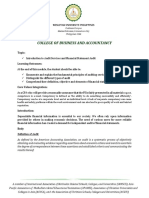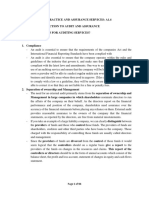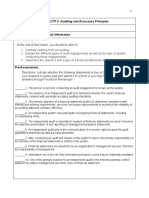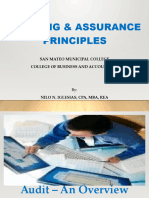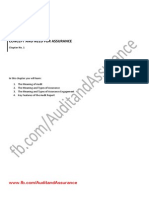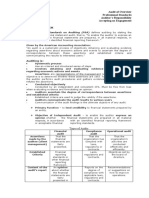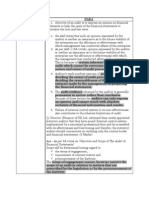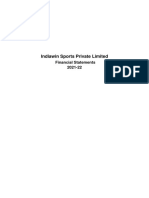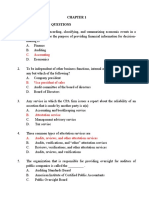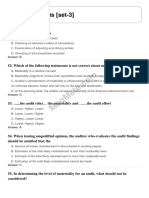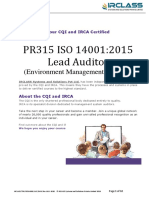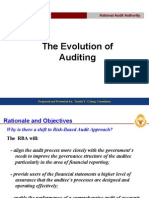PSBA - Introduction To Assurance and Related Services
Uploaded by
ephraimPSBA - Introduction To Assurance and Related Services
Uploaded by
ephraimPhilippine School of Business Administration
Manila
Integrated Review - Auditing BLD
2nd Semester 2020-2021
Introduction to Assurance and Non Assurance Engagements
(Including introduction to Auditing)
Types of Engagements
Assurance Non- Assurance
Audit Review Agreed Upon Compilation Other Non-
Procedure Assurance
Reasonable Limited No Assurance No Assurance No Assurance
Positive Negative No Assurance No Assurance No Assurance
Assurance Assurance
Audit Opinion Review Report on Compiled Data -
Opinion Factual
Findings
Independence Independence Independence Independence Independence
Required Required Not Required Not Required Not Required
According to scope of service
1. Assurance Engagements - Broadest
2. Attestation - Broader
3. Audit -Broad
The five elements:
ü A three-party relationship, involving: the practitioner, a responsible party and intended users.
ü Appropriate subject matter.
ü Suitable criteria.
ü Sufficient, appropriate evidence to support the conclusion.
ü A conclusion contained within a written report.
Introduction on Auditing
Dependable financial information is essential to our society. We often rely upon information provided by others
in making economic decisions. The need of various users for more reliable financial information has created a
demand for an independent audit of financial statements.
The primary function of an independent audit is to lend credibility to the financial statements prepared by an
entity. The auditor’s opinion enhances the value and usefulness of the financial statements. By attaching a
report to the financial statements, the auditor provides increased assurance to users that the financial
statements are reliable.
Definition of Auditing
As defined by PSA:
to enable the auditor to express an opinion whether the financial statements are prepared, in all materials
respects, in accordance with an identified financial reporting framework.
As defined by American Accounting Association:
An audit is a systematic process of objectively obtaining and evaluating evidence regarding assertions about
economic actions and events to ascertain the degree of correspondence between these assertions and
established criteria and communicating the results to interested users.
Auditing by: Bee Jay L. De Leon, CPA Page 1
Introduction to Assurance and Non Assurance Engagements
Types of Audit
Based on the primary audit objectives, there are three major types of audit-financial, compliance and
operational units.
• Financial statement audit
This is an audit conducted to determine whether the financial statements of an entity are fairly
presented in accordance with an identified financial reporting framework.
• Compliance audit
Compliance audit involves a review of an organization’s procedures to determine whether the
organization has adhered to specific procedures, rules or regulations. The performance of compliance
audit is dependent upon the existence of verifiable data and recognized criteria established by an
authoritative body. A common example of this type of audit is the examination conducted by BIR
examiners to determine whether entities comply with tax rules and regulations.
• Operational audit
An operational audit is a study of a specific unit of an organization for the purpose of measuring its
performance. The main objective of this type of audit is to assess entity’s performance, identify areas for
improvements and make recommendations to improve performance. This type of audit is also known as
performance audit or management audit.
NOTE: although there are different types of audit, all audit process the same general characteristics. They all
involve:
1. Systematic examination and evaluation of evidence which are undertaken to ascertain whether
assertions comply with established criteria; and
2. Communication of the results of the examination of the results of the examination, usually in a written
report, to the party by whom, or on whose behalf, the auditor was appointed.
Unlike compliance and financial statement audits, where the criteria are usually defined, criteria used in
operational audit to evaluate the effectiveness and efficiency of operations are not clearly established.
Types of auditors
Auditors can be classified according to their affiliation with the entity being examined.
• External auditors
These are independent CPA’s who offer their professional services to different clients on a contractual
basis. External auditors are the ones who generally perform financial statement audits.
• Internal auditors
Internal auditors are entity’s own employees who investigate and appraise the effectiveness and
efficiency of operations and internal controls. The main function of internal auditors is to assist the
members of the organization in the effective discharge of their responsibilities. Internal auditors usually
perform operational audits.
• Government auditors
These are the government employees whose main concern is to determine whether persons or entities
comply with the government laws and regulations. Government auditors usually conduct compliance
audits.
Auditing by: Bee Jay L. De Leon, CPA Page 2
Introduction to Assurance and Non Assurance Engagements
The Independent Financial Statement Audit
The objective of an audit of financial statement is to enable the auditor to express an opinion whether the
financial statements are prepared, in all material respects, in accordance with an identified financial reporting
framework or acceptable financial reporting standards.
• Responsibility for the financial statements.
The management is responsible for preparing and presenting the financial statement in accordance with
the financial reporting framework.
The auditor’s responsibility is to form ad express an opinion on these financial statements based on his
audit. An audit of financial statements does not relieve management of its responsibilities. Hence, it is
management’s responsibility to adopt and implement adequate accounting and internal control systems
that will help ensure, among others, the preparation of reliable financial statements.
• Assurance provided by the auditor
the auditor’s opinion on the financial statements is not a guarantee that the financial statements are
dependable. An audit conducted in accordance with Philippine Standards on Auditing (PSAs) is designed
to provide only reasonable assurance (not absolute assurance) that the financial statements taken as a
whole are free from material misstatements. In every audit, there are always inherent limitations that
affect the auditor’s ability to detect material misstatements. These limitations result from such factors
as:
1. The use of testing / Sampling risk
For practical reasons, auditors do not examine all evidence available many audit
conclusions are made by examining only sample of evidence. Whenever a sample is
taken, there is always a possibility that the auditor’s conclusion, based on the sample,
may be different from the conclusion that would have been reached if the auditor
examines the entire population.
2. Error in application of judgment / Non-sampling risk
The work undertaken by the auditor to form an opinion is permeated by judgment.
Human weakness can cause auditors to commit mistakes in the application of audit
procedures and evaluation of evidence.
3. Reliance on management’s representation
Some evidence supporting the financial statements must be obtained by obtaining oral
or written representations from management. For example, it is difficult for the auditor
to determine the proper valuation of accounts receivable without management’s honest
assessment. If the management lacks integrity, management may provide the auditor
with false representations causing the auditor to rely on unreliable evidence.
4. Inherent limitations of the client’s accounting and internal control systems.
Although the auditor performs procedures to detect material misstatements when
auditing financial statements, such procedures may not be effective in detecting
misstatements resulting from collusion among employees or management’s
circumvention of internal control.
5. Nature of evidence
Evidence obtained by the auditor does not consist of “hard facts” which prove or
disprove the accuracy of the financial statements. Instead, it comprises pieces of
information and impressions which are gradually accumulated during the course of an
audit and which, when taken together, persuade the auditor about the fairness of the
financial statements Thus, audit evidence is generally persuasive rather than conclusive
in nature.
General Principles governing the audit of financial statements
1. “Code of professional Ethics for Certified Public Accountants”
2. Philippine Standards on Auditing
3. Professional Skepticism
Auditing by: Bee Jay L. De Leon, CPA Page 3
Introduction to Assurance and Non Assurance Engagements
Need for an independent financial statement audit
The need for an independent audit of financial statements’ stems from the following The need for an
independent audit of financial statements’ stems from the following interrelated sources:
1. Conflict of interest between management and users of financial statements.
In a sense, financial statements may be viewed as the report by management as to how the entity
performed under their direction and supervision. Managers are frequently placed in positions
where they can benefit by providing outside parties with overly optimistic or even false financial
information. Outside parties, however, want unbiased, realistic financial statements. Recognizing
this inherent conflict of interest, users of financial statements have become skeptical of unaudited
financial statements.
2. Expertise
The complexity of accounting and auditing requires expertise in verifying the quality of the financial
information. Since most of the users of financial information are not equipped with the necessary
skills and competence to determine whether the financial statements are reliable, a qualified person
is hired by users to verify the reliability of the financial statements on their behalf.
3. Remoteness
Users of financial information are usually prevented from directly assessing the reliability of the
information. Most of the users do not have access to the entity’s records to personally verify the
quality of the financial information. Consequently, an independent auditor is needed to assist them
in verifying the reliability of the financial information.
4. Financial consequences
Misleading financial information could have substantial economic consequences for a decision
maker. It is therefore important that financial statements be audited first before they are used for
making important decisions.
Theoretical framework of Auditing
The audit function operates within a theoretical framework. Below are selected postulates, assumptions or ideas
that support many auditing concepts and standards.
1. Audit function operates on the assumption that all financial data are verifiable.
2. The auditor should always maintain independence with respect to the financial statements
under audit
3. There should be no long-term conflict between the auditor and the client management.
4. Effective internal control system reduces the possibility of errors and fraud affecting the financial
statements.
5. Consistent application of generally accepted accounting principles (GAAP) or Philippine Financial
Reporting Standards (PFRS) results in fair presentation of financial statements.
6. What was held true in the past will continue to hold true in the future in the absence of known
conditions to the contrary.
7. An audit benefits the public.
MULTIPLE CHOICE QUESTIONS
1. Providing quantitative information that management and others can use to make decisions is the function
of
A. Accounting
B. Auditing
C. Finance
D. Management of information systems
2. The series of tasks and records of an entity by which transactions are processed as a means of maintaining
Auditing by: Bee Jay L. De Leon, CPA Page 4
Introduction to Assurance and Non Assurance Engagements
financial records.
A. Accounting system
B. Computer information system
C. Control environment
D. Internal control system
3. The expertise that distinguishes auditors from accountants is in the
A. Ability to interpret accounting standards.
B. Accumulation and interpretation of evidence
C. Ability to interpret generally accepted accounting principles.
D. Requirement to possess education beyond the Bachelor’s degree.
4. Comprises officers and others who also perform senior managerial functions.
A. Audit committee C. Governance
B. Board of directors D. Management
5. An audit conducted to determine whether an entity is following specific procedures or rules set down by
some higher authority.
A. Compliance audit C. Financial audit
B. Detailed audit D. Operational audit
6. A review of any part of an organization’s and methods for the purpose of evaluating efficiency and
effectiveness is classified as a(n)
A. Audit of financial statements
B. Compliance audit
C. Operational audit
D. Production audit
7. Operational auditing is primarily oriented toward
A. Past protection provided by existing internal control.
B. Future improvements to accomplish the goals of management.
C. The accuracy of data reflected in management’s financial records.
D. The verification that a company’s financial statements are fairly presented.
8. A typical objective of an operational audit is
A. Make recommendations for improving performance.
B. Evaluate the feasibility of attaining the entity’s operational objectives.
C. Report on the entity’s relative success in attaining profit maximization.
D. Determine whether the financial statements fairly present the entity’s operations.
9. Under the law, the chief executive officer of the Commission on Audit is the
A. Chairman. C. Commissioner.
B. Commission Secretary. D. Executive Director.
10. One of the government auditing standards which is not observed by independent CPAs in the private
sector is:
A. An evaluation shall be made of the system of internal control.
B. A review shall be made of compliance with legal and statutory requirements.
C. The audit is to be adequately planned and assistants are to be properly supervised.
D. Sufficient competent evidential matter shall be obtains through inspection, observation, inquiries
and confirmations.
11. Which of the following is more difficult to evaluate objectively?
A. Compliance with government regulations.
B. Efficiency and effectiveness of operations.
C. Presentation of financial statements in accordance with generally accepted accounting principles.
D. All three of the above are equally difficult.
12. The Core Competencies of CPAs include:
A. Assurance and information integrity.
B. Objectivity.
C. Pursuit of life-log learning and excellence.
D. Strategic and critical thinking skills.
Auditing by: Bee Jay L. De Leon, CPA Page 5
Introduction to Assurance and Non Assurance Engagements
13. __________ refers to the application of relevant training, knowledge and experience, within the context
provided by auditing, accounting and ethical standards in making informed decisions about the course of action
that are appropriate in the circumstances of the audit engagement.
A. Compliance. C. Professional judgment.
B. Professional competence. D. Reasonable assurance.
14. While performing services for their clients, professionals have a duty to provide a level of care which is
A. Free from judgment errors C. Reasonable
B. Greater than average D. Superior
15. “Absence of reasonable care that can be expected of a person in a set of circumstances” is the definition
of
A. Constructive fraud C. Gross negligence
B. Fraud D. Ordinary negligence
Auditing by: Bee Jay L. De Leon, CPA Page 6
You might also like
- IT-6 Flowchart Diagram (Payroll Processing)100% (1)IT-6 Flowchart Diagram (Payroll Processing)5 pages
- Unit 1 RightsDuties and Liabilities of An AuditorNo ratings yetUnit 1 RightsDuties and Liabilities of An Auditor18 pages
- 06 Exercises Workbook - ISO 9001-QMS LATC V 1.5100% (1)06 Exercises Workbook - ISO 9001-QMS LATC V 1.550 pages
- Chapter 1 Introduction To Assurance Engagements - PPT 1704069091100% (1)Chapter 1 Introduction To Assurance Engagements - PPT 170406909170 pages
- IR4&6 - at 01 - Introduction To Assurance and Related Services (Incl. Intro To Audit)No ratings yetIR4&6 - at 01 - Introduction To Assurance and Related Services (Incl. Intro To Audit)5 pages
- Auditing & Assurance Principles-Lesson 1No ratings yetAuditing & Assurance Principles-Lesson 112 pages
- Audit Practice and Assurance Services - A1.4 PDFNo ratings yetAudit Practice and Assurance Services - A1.4 PDF94 pages
- Audit 0 Investigation Presentation Module 1 To 3No ratings yetAudit 0 Investigation Presentation Module 1 To 372 pages
- Post Test: Lesson 1: Introduction To AuditingNo ratings yetPost Test: Lesson 1: Introduction To Auditing2 pages
- Lesson 1 - Overview of The Risk-Based Audit ProcessNo ratings yetLesson 1 - Overview of The Risk-Based Audit Process7 pages
- Applied Auditing Report Cabral and de JesusNo ratings yetApplied Auditing Report Cabral and de Jesus12 pages
- Module 1 Introduction To Assurance EngagementsNo ratings yetModule 1 Introduction To Assurance Engagements70 pages
- Lesson Number: 02 Topic: Audits of Financial Information Learning ObjectivesNo ratings yetLesson Number: 02 Topic: Audits of Financial Information Learning Objectives18 pages
- Topic 8_Assurance and Non-Assurance RelatedNo ratings yetTopic 8_Assurance and Non-Assurance Related49 pages
- SY 2023-2024 Module 1 - Introduction (1)No ratings yetSY 2023-2024 Module 1 - Introduction (1)6 pages
- Module 2 Auditing and Assurance PrinciplesNo ratings yetModule 2 Auditing and Assurance Principles7 pages
- Week 1 Overview of Audit - ACTG411 Assurance Principles, Professional Ethics & Good GovNo ratings yetWeek 1 Overview of Audit - ACTG411 Assurance Principles, Professional Ethics & Good Gov6 pages
- Introduction To Auditing: Reference: Chapter Two of Audit and Assurance PrincipleNo ratings yetIntroduction To Auditing: Reference: Chapter Two of Audit and Assurance Principle25 pages
- PSBA - GAAS and System of Quality ControlNo ratings yetPSBA - GAAS and System of Quality Control10 pages
- Absorption and Variable Costing Reviewer Eph100% (1)Absorption and Variable Costing Reviewer Eph4 pages
- Treasury Management Vs Cash Management Answer To Warm Up Exercises0% (1)Treasury Management Vs Cash Management Answer To Warm Up Exercises8 pages
- Philippine School of Business Administration - PSBA ManilaNo ratings yetPhilippine School of Business Administration - PSBA Manila12 pages
- Applied Auditing Quiz #1 (Diagnostic Exam)No ratings yetApplied Auditing Quiz #1 (Diagnostic Exam)7 pages
- Chapter 3 Audit Documentation and Audit Evidence - ScannerNo ratings yetChapter 3 Audit Documentation and Audit Evidence - Scanner100 pages
- IS Auditing Tools and Tech - Res - Eng - 0215 PDFNo ratings yetIS Auditing Tools and Tech - Res - Eng - 0215 PDF46 pages
- Group 1 Chapter 1 The Demand For Auditing and Assurance ServicesNo ratings yetGroup 1 Chapter 1 The Demand For Auditing and Assurance Services23 pages
- Bihar Self Supporting Co Operative Societies Amendment Act2008No ratings yetBihar Self Supporting Co Operative Societies Amendment Act200817 pages
- Auditing 2&3 Theories Reviewer CompilationNo ratings yetAuditing 2&3 Theories Reviewer Compilation9 pages
- CHAP 1.the Demand For Audit and Other Assurance ServicesNo ratings yetCHAP 1.the Demand For Audit and Other Assurance Services11 pages
- Pecb Iso 21001 Lead Auditor Exam Preparation Guide100% (1)Pecb Iso 21001 Lead Auditor Exam Preparation Guide14 pages
- EMS-LAC-Delegate Activity Manual - VILT - CR - 08 - 2021100% (2)EMS-LAC-Delegate Activity Manual - VILT - CR - 08 - 202132 pages
- BAA6003 2 Substantive and Compliance Testing RefresherNo ratings yetBAA6003 2 Substantive and Compliance Testing Refresher16 pages
- Environmental Audit Practices in India: AbhinavNo ratings yetEnvironmental Audit Practices in India: Abhinav7 pages
- Chapter 1 Introduction To Assurance Engagements - PPT 1704069091Chapter 1 Introduction To Assurance Engagements - PPT 1704069091
- IR4&6 - at 01 - Introduction To Assurance and Related Services (Incl. Intro To Audit)IR4&6 - at 01 - Introduction To Assurance and Related Services (Incl. Intro To Audit)
- Lesson 1 - Overview of The Risk-Based Audit ProcessLesson 1 - Overview of The Risk-Based Audit Process
- Lesson Number: 02 Topic: Audits of Financial Information Learning ObjectivesLesson Number: 02 Topic: Audits of Financial Information Learning Objectives
- Week 1 Overview of Audit - ACTG411 Assurance Principles, Professional Ethics & Good GovWeek 1 Overview of Audit - ACTG411 Assurance Principles, Professional Ethics & Good Gov
- Introduction To Auditing: Reference: Chapter Two of Audit and Assurance PrincipleIntroduction To Auditing: Reference: Chapter Two of Audit and Assurance Principle
- Treasury Management Vs Cash Management Answer To Warm Up ExercisesTreasury Management Vs Cash Management Answer To Warm Up Exercises
- Philippine School of Business Administration - PSBA ManilaPhilippine School of Business Administration - PSBA Manila
- Chapter 3 Audit Documentation and Audit Evidence - ScannerChapter 3 Audit Documentation and Audit Evidence - Scanner
- Group 1 Chapter 1 The Demand For Auditing and Assurance ServicesGroup 1 Chapter 1 The Demand For Auditing and Assurance Services
- Bihar Self Supporting Co Operative Societies Amendment Act2008Bihar Self Supporting Co Operative Societies Amendment Act2008
- CHAP 1.the Demand For Audit and Other Assurance ServicesCHAP 1.the Demand For Audit and Other Assurance Services
- Pecb Iso 21001 Lead Auditor Exam Preparation GuidePecb Iso 21001 Lead Auditor Exam Preparation Guide
- EMS-LAC-Delegate Activity Manual - VILT - CR - 08 - 2021EMS-LAC-Delegate Activity Manual - VILT - CR - 08 - 2021
- BAA6003 2 Substantive and Compliance Testing RefresherBAA6003 2 Substantive and Compliance Testing Refresher












